Versatility and efficiency drive health care lighting
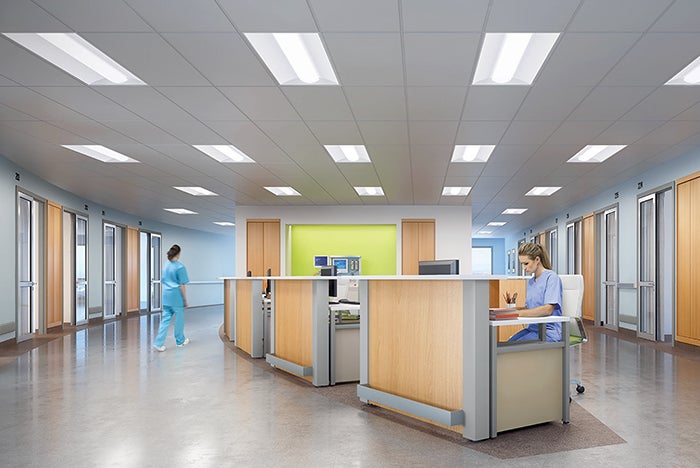
Image courtesy of Eaton Corp.
Hospital lighting fixtures and equipment must enhance the patient experience and the staff’s ability to provide a high level of care. Moreover, they must address the needs of specialized care areas throughout the hospital to support a diverse range of activities 24 hours a day.
Hospitals and clinics have a special need for low-flicker or flicker-free fixtures to protect patients and visitors who have photo-sensitive epilepsy/seizure disorders, especially in stairwells and other fall-risk areas. Many areas of hospitals and clinics also are sensitive to noise and disruption, so it’s important to choose fixtures that install quickly and easily, according to Jeff Hungarter, director of indoor lighting at Cree Lighting, Durham, N.C.
Engineering lighting products in health care environments have compliance considerations as well, according to Les Kaminski, vice president of operations and product management at Waldmann Lighting, Wheeling, Ill. “Our Derungs lighting products maintain all medical certifications necessary for safe use in a hospital,” he says. “We also source materials that are durable enough to hold up to the rigorous cleaning and disinfecting procedures required.”
The LED revolution
The good news for health care facilities is that manufacturers have developed a wide range of innovations.
For instance, light-emitting diode (LED) fixtures are used throughout hospitals today. Lumen requirements have increased, and the life of high-quality LEDs has been extended up to 80,000 hours. “Exam lighting fixture footprints are becoming smaller and more ergonomic, while hospital facility lighting is being controlled by systems that provide energy efficiency metrics,” Kaminski says.
Originally, the performance of LED fixtures versus fluorescent and high-intensity discharge (HID) was not too far apart in terms of efficacy. However, pricing, which was an initial impediment, has continued to drop, as has the robustness and efficacy of LEDs, according to Josh Linenberger, vice president at Atrius Applied Solution Sales, Acuity Brands Inc., Atlanta.
“The lower price points and increased efficacy have resulted in a considerable difference from the prior generation of products; there is a better return on investment, which is making a stronger case for the conversion to LED,” Linenberger says. “The improved robustness of LEDs and drivers has opened that segment of the market for good quality fixtures. Acuity Brands is seeing more growth in that segment.”
LED fixtures have become the design standard for new lighting in health care projects, owing to the form, function and budget of new LED products, according to Sally Lee, business development manager at Ledvance GmbH, Wilmington, Mass., maker of Sylvania general lighting in the United States and Canada. “There really hasn’t been any development that isn’t LED, including medical equipment design. The lighting design process of ‘starting with the light source’ hasn’t really changed, despite the source being integrated into the fixture.”
Health care lighting design still requires a careful process of lighting product specification that meets the owner’s project requirements, including budget and maintenance. “One challenge of fully integrating LED fixtures into health care facilities is the question of lighting maintenance, because it’s no longer a matter of simply changing out lightbulbs, especially if rooms must be decommissioned in order to prevent exposing patients to pollutants,” Lee adds.
Most LED fixtures available today have been completely redesigned to accommodate the unique characteristics of the light source. These new fixtures deliver efficient lighting with improved control, enabling them to project light farther from the light source, according to Nishad Chikhliker, lighting segment and commercialization marketing manager at Connected Buildings – Eaton, Peachtree City, Ga. “LED provides excellent color rendering and a consistent color of white light throughout the facility, along with energy efficiency and the ability to meet building codes and green building initiatives,” he says.
LED fixtures offer more light with less energy, little heat production, controllability and a fraction of traditional lighting maintenance requirements. “As the technology has advanced, many people feel more comfortable with LED because the light appears brighter, has better color and produces a more uniform illumination than fluorescent products,” Chikhliker adds.
Converting to LED is an increasingly easy and viable way to help health care facilities, both big and small, reduce energy, maintenance and operational costs. “The important thing to consider is that lighting also directly effects how people feel and function,” says Nitin Tyagi, health care and industry product manager at Signify, Somerset, N.J. “Therefore, the quality of light should be evaluated not just in terms of how much energy it saves, but how it can better support the daily activities of patients, their families and hospital staff.”
Sylvania LED troffer retrofit kits offer easy conversion from fluorescent to LED fixtures, and up to 50 percent in energy savings. The kits feature safe, easy installation in less than four minutes, and they bypass the existing ballast to eliminate incompatibility issues. “This is ideal for hospitals because you don’t need to break the ceiling to perform the lighting upgrade, therefore reducing the possibility of dust and other materials falling into the space,” Lee explains.
Other innovations
Among many other LED innovations recently introduced to the health care market, the MediMode Behavioral lighting fixture from Hubbell Healthcare Solutions, Greenville, S.C., provides primary lighting requirements for the patient environment while addressing the safety and security concerns of behavioral health spaces, according to Michael McCullough, director of public relations. The construction is designed to reduce risk of ligature self-harm, hiding of contraband and general damage to the fixture.
Available in a multifunction model (DS option) that provides ambient/reading and exam illumination and in an ambient model (SS option), the MediMode Behavioral features a one-piece, cold rolled steel (CRS) door frame with 0.250-inch clear polycarbonate lens and tamper-resistant hardware. Optical assembly and electrical components are accessible from below the ceiling.
Signify recently introduced a RelaxView Healthcare Lighting System, which features LED graphic panels that can be mounted on the ceiling or wall as a distraction for patients during long procedures while providing health care professionals with general ambient lighting to aid in the performance of their tasks. Wall dimmers and power distribution modules provide additional control of the environment for the task at hand.
Signify also has unveiled the SurgiCare LED fixture, which is completely sealed for maximum protection in the surgical suite. “The housing has no openings above the ceiling, and the luminaire is sealed to the structure with gaskets. Safety cables hold the door securely to the housing for ease of maintenance,” Tyagi explains.
Waldmann has introduced recessed over-bed lights, Stellar and Stellar Duo, for patient room ceilings in the North American market. The fixtures are space-saving and provide an alternative design option from the company’s other headwall bed light offerings, according to Kaminski. The Stellar Duo Light offers three lighting functions: ambient, exam and reading. Lenses and reflectors offer clean, glare-free light to help caregivers perform their tasks.
Waldmann’s Derungs brand has unveiled the Triango-100 procedure light, which features 100,000 lux light output at 1 meter with shadow-free, uniform illumination, an adjustable light field from 6 to 11 inches and an ergonomic, contoured light head design. It has four dimming levels and is available with adjustable color temperatures.
Cree Lighting has introduced The Cadiant Experience, an LED lighting solution that delivers both the architectural impact and the sensory experience of a true skylight, according to Hungarter. It features dimensional LED panels that simulate the depth of field, shifting sun positions, clouds and natural hues of an actual sky. “Wherever natural light is desired but lacking, this lighting solution brings the outdoors inside by mirroring the natural arc of the sun as it crosses the sky and recreating local weather conditions — from bright, sunny mornings to overcast, cloudy afternoons,” he says.
The Cadiant Experience can serve as the primary light source in patient rooms, exam rooms and smaller spaces, and will work in concert with other types of fixtures in larger areas such as nurse stations, waiting areas, lobbies and break rooms. “The Cadiant Experience is code-compliant and employs standalone Cree SmartCast Technology, which does not require IT integration or approval. An intuitive, wall-mounted touchscreen gives users fingertip control over multiple installations,” Hungarter adds.
Eaton has introduced VividTune color tunable solutions, which allow health care facilities to achieve the right color temperature and intensity by balancing circadian rhythms. “With tunable solutions, users can choose from a wide range of correlated color temperature (CCT) settings as the time of day or need of the hour changes. They can maintain a fixed color temperature and adjust it up and down without affecting the light output intensity,” Chikhliker explains.
Selecting the correct CCT is important for diagnosis, he adds. In patient rooms or other diagnostic areas, light fixtures must be able to render the true color of objects, materials and skin tones. This is important, as physicians evaluate the color of a patient’s skin, eyes and organs to diagnose conditions and track recovery.
WAC Lighting, Port Washington, N.Y., recently enhanced its line of architectural fixtures with an antimicrobial powder-coat finish that restrains the growth of pathogens on surfaces. This feature is offered in the company’s LED step lights, LED under-cabinet bar lights and LED puck lights. “Step lights often are used as nightlights in patient rooms with our amber LED option. We also have retrofitted step lights in children’s hospitals where they are used for wayfinding as our LED step lights are not hot to the touch,” says Shelley Wald, president.
Specifiers also are placing decorative pendants and sconces from both WAC Lighting and its Modern Forms unit in the lobbies and waiting rooms of health care facilities, as well as in patient rooms.
“We offer many high-design looks that designers need to achieve the upscale, contemporary hospitality feel that is desired in today’s patient-centric facilities,” Wald says. “We also offer emergency battery backup wall sconces and recessed lights for designers who need to meet power outage requirements without adding overhead troffers, which are detrimental to the aesthetics of a space.”
Optimizing for people
As the commercial LED lighting industry matures, the emphasis on product performance is beginning to shift from optimizing building functions to optimizing for people, according to Tom Hinds, director of intelligent lighting at Cree Lighting.
“The [International WELL Building Institute’s] WELL Building Standard is the new LEED, and whether facility professionals are yet pursuing this kind of health-centric building certification or not, they must see the trend,” Hinds says. The WELL Building Standard is a performance-focused system for measuring, certifying and monitoring features of the built environment that impact health.
“Energy efficiency, low maintenance and sustainability are still important, but they are just table stakes now,” Hinds says. “Building managers want better light quality — light that can be tuned to particular tasks, personal preferences and the time of day as well as intelligent [features] that offer non-visual benefits such as circadian activation.”
Neal Lorenzi is a freelance writer and regular contributor based in Mundelein, Ill.
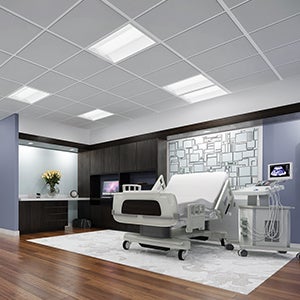
PERFECT HARMONY
Metalux Cruze recessed troffer features the VividTune white tuning capabilities, and combines contemporary styling and optimal illumination design with a linear LED platform for enhanced energy savings, comfort and aesthetics. Eaton Corp.

FAMILIAR ATMOSPHERE
The Cadiant Experience is an LED lighting solution that delivers both the architectural impact and the sensory experience of a true skylight. Cree Inc.

SAFE SETTING
MediMode Behavioral lighting fixtures are designed to reduce risk of ligature self-harm, hiding of contraband and general damage to the luminaire. Hubbell Healthcare Solutions

MADE WITH PURPOSE
The SurgiCare LED fixture is completely sealed for maximum protection in the surgical suite. Signify
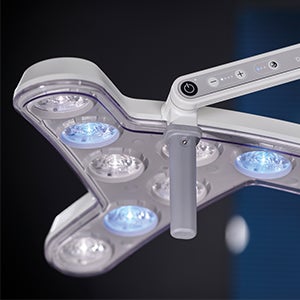
SET THE SCENE
The Derungs Triango procedure light features four dimming levels and is available with adjustable color temperatures. Waldmann Lighting
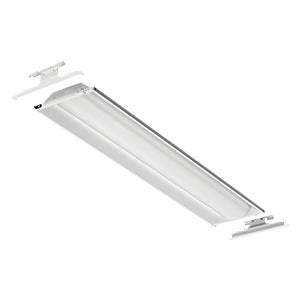
WELL CONNECTED
LED luminaires can be enabled with advanced solutions such as Atrius, an “internet of things” application that enables digital capabilities. Acuity Brands Inc.
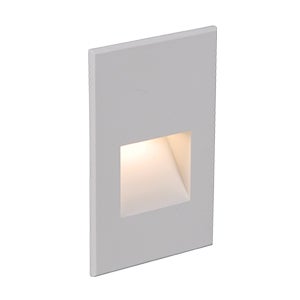
PROPERLY LIT
LED step and wall lights illuminate stairs, walls and walkways with little or no glare. WAC Lighting
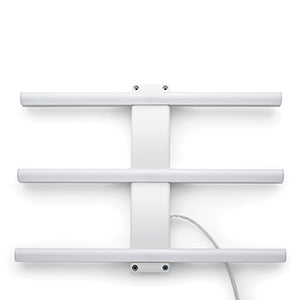
OUT WITH THE OLD
Troffer retrofit kits offer easy conversion from fluorescent to LED fixtures and up to 50 percent in energy savings. Ledvance GmbH




